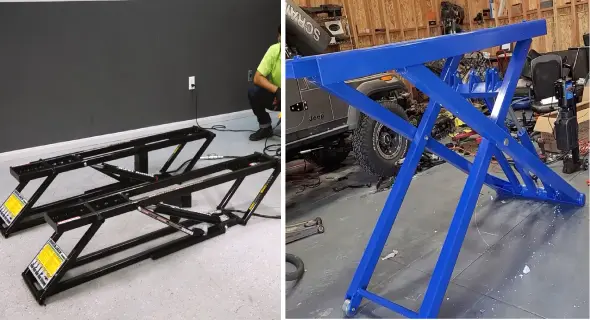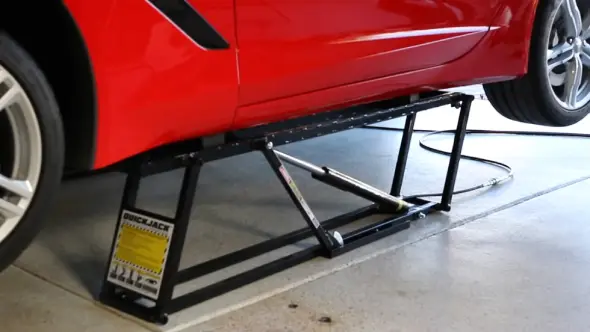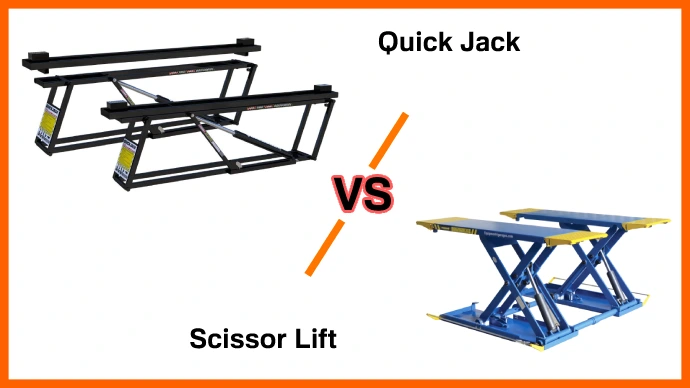Last Updated on June 6, 2023
QuickJack and Scissor Lift are two standard tools used for automotive work. Whether for changing tires or more advanced jobs like brake repairs, having the right tool is essential.
Both options provide a safe, easy, and effective way to lift your vehicle off the ground, but which one is better? QuickJack is perfect for easy-to-move for light projects, while a scissor jack is ideal for heavy lifting with higher capacity levels.
Before deciding, consider factors such as lifting capacity, weight capacity, portability, and time to set up to ensure safety during operation. We’ll compare them to help you determine which portable car lift is right for the job.
Comparison Between Quick Jack vs Scissor Lift

QuickJack and Mid-Rise Scissor Lifts are two popular garage tools used for lifting vehicles. QuickJacks are ideal for low-profile vehicles and those looking for quick lifts with a smaller price tag, while scissor lifts offer a wider range of motion and more weight capacity.
1. Maximum Lift Height:
The biggest difference between a QuickJack and a Mid Rise Scissor Lift is their maximum lift height. QuickJacks have a limit of 28 inches, while scissor lifts can reach up to 56 inches.
This makes QuickJacks perfect for low-profile cars or those with limited headroom. But it also limits its capacity for larger vehicles or those needing additional space underneath.
2. Weight Capacity:
Considering their size, weight capacity is another important factor when comparing QuickJacks and scissor lifts. The Quick Jack typically ranges from 3,500 to 6,000 pounds, while the latter can go up to 7,000+ pounds in some cases.
This means that while QuickJacks are great for lighter vehicles like sedans and small trucks, they won’t be able to lift anything too heavy, like heavier trucks or industrial equipment.
Conversely, Mid-Rise Scissor Lifts have more than enough power to handle any job necessary since they can easily support even heavier loads.
3. Weight and Portability:
One key difference is in the portability of each device. A quick car jack features an open center design and has built-in hydraulic flow dividers, which make it portable and lightweight.
It generally weighs between 100-300 pounds and can be easily moved for repair or replacement. This low rise lift is far more portable than scissor lifts, making it a popular choice for home garages and workshops.
Mid-rise scissor lifts, on the other hand, weigh around 1000 lbs and can be more difficult to move from one place to another. It has an “X” layout that allows it to lay flat on the garage floor while having swing arms for jacking points.
It is powered by two hydraulic cylinders driven by an electric pump. It is designed to remain stationary until raised by crossed beams.
4. Built-In Material and Lifespan:
Quick jacks are typically made of alloy steel, which is low maintenance and highly durable. Scissor lifts are usually constructed with alloy steel, iron, and rubber components. It makes them both strong and resistant to wear over time. However, they require routine maintenance to ensure their longer lifespan.
5. Time to Set-Up:
Quick Jacks are much faster and easier to set up than traditional Scissor Lifts. This is due to its lightweight construction and the fact that it can be quickly set up with minimal effort.
On the other hand, scissor car lifts are generally heavier than Quick floor jacks and require more time and effort to assemble. Thus it is a slower process to set-up.
6. Safety
The other difference between a Quick Jack and a Scissor Lift lies in their safety mechanisms. The Quick Jack utilizes an auto-locking safety bar to prevent unwanted lowering, making it safer than a mid rise lift for wider vehicles.
Additionally, it must be used on a flat surface. Any slope of more than three degrees is not considered safe.
On the other hand, a Scissor Lift uses mechanical safety stops to prevent the lift from lowering in the event of failure. It must also be used on a flat and even surface.
7. Applications:
Quick Jacks are ideal for home garages, small repair shops, and trackside applications for SUVs at a garage.
On the other hand, Scissor Lifts are better suited for wheel and tire swaps, brake jobs, suspension overhauls, and body repairs. These mid-rise lifts are more suitable for commercial garages or workshops as they provide increased stability when lifting heavier loads.
They also offer larger workspaces, making them ideal for repairs and maintenance tasks.
8. Access to Underside of Vehicle:
Access to your car’s underside is imperative for many quick tasks and maintenance checkups. QuickJack’s open-center design offers advantages that traditional scissor-type jacks don’t, such as allowing the center of the car’s underside to remain easily accessible.
However, this design has a slight tradeoff, as side access may be slightly reduced compared to larger models.
9. Price Range:
While this isn’t always indicative of quality or performance, it’s still an important factor when deciding between these two tools. Generally speaking, QuickJacks will cost anywhere from $1,300-$2,150, whereas Mid-Rise Scissor Lifts will come in at around $1,500-$2,500, depending on size and brand.
Which is Better: QuickJack or Scissor Jack?

The choice between a QuickJack or a scissor jack will depend largely on the application and one’s individual needs. For lighter applications that require portability, quicker set-up times, safety, and a lower price range, QuickJack is the better option.
However, if maximum lifting capacity, heavy weight capacity and long-term durability are desired in heavier applications, a scissor jack is the better choice. Regarding access to the vehicle’s underside, QuickJack is more advantageous as it requires no additional lifting tools or devices.
Ultimately, each user must assess their requirements when choosing between these two types of jacks.
Can You Use Just One Quickjack?
You cannot use just one Quickjack to lift an entire vehicle. Quickjacks are usually designed for lifting two sides of a car simultaneously, and altering this configuration could be dangerous.
To ensure the vehicle’s and its occupants’ safety, it is always recommended to use two Quickjacks when performing any type of maintenance or repairs.
How Long Can a Car Stay on a Quickjack?
The length of time that a car can stay on a Quickjack depends on several factors, including the weight capacity of the lift and any time limits specified by the manufacturer.
Generally speaking, Quickjacks are designed for short-term use to help with maintenance and repair. However, mechanical safety locks can be adjusted to raise and store vehicles indefinitely.
Can You Drive Over Quick Jacks?
You should not drive your car over Quickjacks as they are not designed to support the weight of a car while in motion. Driving over a QuickJack can damage either the lift or your vehicle itself, so it is important to follow all manufacturer guidelines when using them.
If you need access between frames and the floor, you can drive “over” them, but only if no space is visible between the frame and floor.
Can You Drop a Transmission with Quickjack?

You can drop a transmission using Quickjack. However, you must follow proper safety procedures as specified in the manufacturer’s instructions and use additional support stands or blocks to ensure car stability.
If the transmission is of a low profile, you should be able to use this transmission jack without any problems. On the other hand, if it is bulky, there may be clearance issues when using Quickjack.
Can Quick Jacks Get Wet?
Quick Jacks are designed to withstand wet conditions and can be used for power washing and detailing after disconnecting the power unit. It is important to note that while it is safe to use in these environments, it is recommended that you take necessary precautions beforehand.
Can You Work Under Quickjack?
It is perfectly safe to work under a Quickjack system due to its dual lock bars on each side, which lock the system like a two or four-post lift. This feature ensures added security while working under this system and allows you to confidently do various jobs, knowing your car is properly secured.
Use the Right Automotive Lift For Your Vehicle Maintenance
Both QuickJack and Scissor Lift offer great advantages when working on automobiles. When comparing them, several factors should be considered, such as lifting height, weight capacity, portability, built-in material, time to set up, safety levels, and applications.
Whether you choose QuickJack or Scissor Lift for your automotive project, both lifts offer unique benefits and are suitable for different tasks. Ultimately it depends on what type of job you plan on using them for, as each option has its strengths and weaknesses that may be better suited for different types of automotive work.

